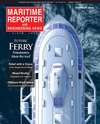
Page 29: of Maritime Reporter Magazine (February 2019)
Ferry Builders
Read this page in Pdf, Flash or Html5 edition of February 2019 Maritime Reporter Magazine
FERRY OPERATORS • The World’s Best
MORE THAN HALF OF
WASHINGTON STATE
FERRIES’ 23-VESSEL
FLEET IS SCHEDULED
TO BE RETIRED BY 2040. ThE FERRY sYs-
TEM NEEds 16 NEw vEssEls iN ThE
Suquamish in Elliott Bay
NExT 20 YEARs, IN- during sea trials in July 2018.
CLUDING 13 FERRIES
Photo: Washington State
Department of Transportation
TO REPLACE VESSELS
DUE FOR RETIREMENT
AND THREE ADDITION-
AL VESSELS …cAlls
FoR ElEcTRiFYiNg
ThE FERRY FlEET To
REdUcE FUEl UsE,
EMissioNs, NoisE
ANd MAiNTENANcE cosTs.”
C
M
Y
CM
MY as far as north as Prince Rupert, is con-
CY verting two of its largest vessels to LNG.
Its Spirit of British Columbia (2,100
CMY passengers/crew and 358 cars capacity)
K returned to service in June, 2018 after being converted at the Remontowa Ship
Repair Yard S.A., in Gdansk to run on
LNG. The vessel is serving the Vancou- ver (Tsawwassen) to Victoria (Swartz
Bay) run. Its sister vessel, Spirit of
Vancouver Island, is expected to com- plete its conversion in mid 2019. Three smaller vessels, dual fueled with LNG or low sulfur diesel fuel, Salish Orca, Sal- ish Eagle, and Salish Raven (each 600 passengers/ crew and 138 cars capacity serving other parts of the system) were delivered to BC Ferries from the Polish yard, all in 2017.
Ferry operators in the San Francisco
Bay region are at the forefront of moves to non-fossil fuel sources, especially re- newable diesel (fuel made from animal fats and greases, for example). A num- ber of the operators around the Bay Area are in the early stages of this transition, in 2019- these include private operators
Hornblower, Golden Gate Ferry, Blue and Gold, and the municipal operator www.marinelink.com 29

 28
28

 30
30
